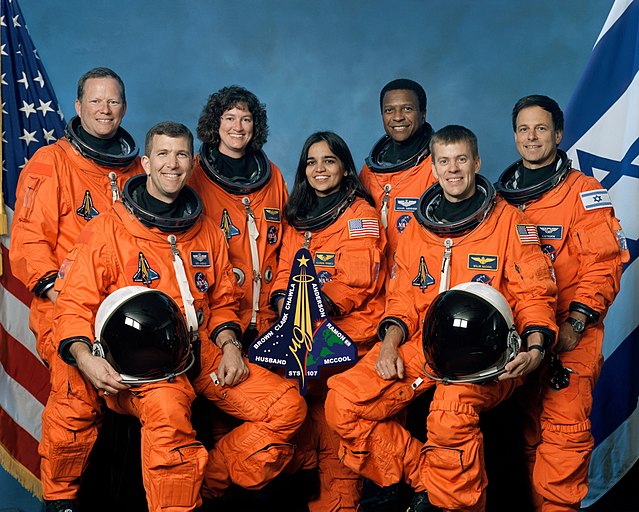American Space Shuttle orbiter From Wikipedia, the free encyclopedia
The Space Shuttle Columbia (OV-102) was a spacecraft used by NASA to fly into outer space. It was the first Space Shuttle to fly into space, on April 12, 1981. It broke apart while re-entering the Earth's atmosphere on February 1, 2003, killing all seven people who were on it at the time. The shuttle flew a total of 28 missions. The Columbia was named after a US Navy ship that circumnavigated the world in 1836.[1] It was also the name of the Apollo 11 Lunar Excursion Module.

A piece of insulating foam from the external fuel tank peeled off during the launch 16.0 days earlier and struck the shuttle's left wing.[2]
A hole was punctured in the leading edge of the wing. During the intense heat of re-entry, hot gases entered the interior of the wing, destroying the support structures and causing the rest of the shuttle to break apart.[3]

| # | Date | Designation | Launch pad | Landing location | Notes |
|---|---|---|---|---|---|
| 1 | 12 April 1981 | STS-1 | 39-A | Edwards Air Force Base | First Shuttle mission |
| 2 | 12 November 1981 | STS-2 | 39-A | Edwards Air Force Base | First re-use of manned space vehicle |
| 3 | 22 March 1982 | STS-3 | 39-A | White Sands Space Harbor | First mission with an unpainted External tank. Only time that a space shuttle has landed at the White Sands Space Harbor. This launch was dedicated by Ronald Reagan to "the people of Afghanistan". |
| 4 | 27 June 1982 | STS-4 | 39-A | Edwards Air Force Base | Last shuttle R&D flight |
| 5 | 11 November 1982 | STS-5 | 39-A | Edwards Air Force Base | First four-person crew, first deployment of commercial satellite. |
| 6 | 28 November 1983 | STS-9 | 39-A | Edwards Air Force Base | First six-person crew, first Spacelab. |
| 7 | 12 January 1986 | STS-61-C | 39-A | Edwards Air Force Base | Representative Bill Nelson (D-FL) on board/ final successful shuttle flight before Challenger disaster |
| 8 | 8 August 1989 | STS-28 | 39-B | Edwards Air Force Base | Launched KH-11 reconnaissance satellite |
| 9 | 9 January 1990 | STS-32 | 39-A | Edwards Air Force Base | Retrieved Long Duration Exposure Facility |
| 10 | 2 December 1990 | STS-35 | 39-B | Edwards Air Force Base | Carried multiple X-ray & UV telescopes |
| 11 | 5 June 1991 | STS-40 | 39-B | Edwards Air Force Base | 5th Spacelab - Life Sciences-1 |
| 12 | 25 June 1992 | STS-50 | 39-A | Kennedy Space Center | U.S. Microgravity Laboratory 1 (USML-1) |
| 13 | 22 October 1992 | STS-52 | 39-B | Kennedy Space Center | Deployed Laser Geodynamic Satellite II |
| 14 | 26 April 1993 | STS-55 | 39-A | Edwards Air Force Base | German Spacelab D-2 Microgravity Research |
| 15 | 18 October 1993 | STS-58 | 39-B | Edwards Air Force Base | Spacelab Life Sciences |
| 16 | 4 March 1994 | STS-62 | 39-B | Kennedy Space Center | United States Microgravity Payload-2 (USMP-2) |
| 17 | 8 July 1994 | STS-65 | 39-A | Kennedy Space Center | International Microgravity Laboratory (IML-2) |
| 18 | 20 October 1995 | STS-73 | 39-B | Kennedy Space Center | United States Microgravity Laboratory (USML-2) |
| 19 | 22 February 1996 | STS-75 | 39-B | Kennedy Space Center | Tethered Satellite System Reflight (TSS-1R) |
| 20 | 20 June 1996 | STS-78 | 39-B | Kennedy Space Center | Life and Microgravity Spacelab (LMS) |
| 21 | 19 November 1996 | STS-80 | 39-B | Kennedy Space Center | 3rd Wake Shield Facility flight/ longest Shuttle flight as of 2006 |
| 22 | 4 April 1997 | STS-83 | 39-A | Kennedy Space Center | Microgravity Science Laboratory (MSL)- cut short |
| 23 | 1 July 1997 | STS-94 | 39-A | Kennedy Space Center | Microgravity Science Laboratory (MSL)- reflight |
| 24 | 19 November 1997 | STS-87 | 39-B | Kennedy Space Center | United States Microgravity Payload (USMP-4) |
| 25 | 13 April 1998 | STS-90 | 39-B | Kennedy Space Center | Neurolab - Spacelab |
| 26 | 23 July 1999 | STS-93 | 39-B | Kennedy Space Center | Deployed Chandra X-ray Observatory |
| 27 | 1 March 2002 | STS-109 | 39-A | Kennedy Space Center | Hubble Space Telescope service mission (HSM-3B) |
| 28 | 16 January 2003 | STS-107 | 39-A | Did not land (Planned to land at Kennedy Space Center) | Earth science research mission. Shuttle destroyed during re-entry on 1 February 2003. All seven astronauts on board died. |
Seamless Wikipedia browsing. On steroids.
Every time you click a link to Wikipedia, Wiktionary or Wikiquote in your browser's search results, it will show the modern Wikiwand interface.
Wikiwand extension is a five stars, simple, with minimum permission required to keep your browsing private, safe and transparent.